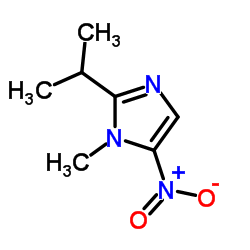ipronidazole

ipronidazole structure
|
Common Name | ipronidazole | ||
|---|---|---|---|---|
| CAS Number | 14885-29-1 | Molecular Weight | 169.181 | |
| Density | 1.3±0.1 g/cm3 | Boiling Point | 309.3±15.0 °C at 760 mmHg | |
| Molecular Formula | C7H11N3O2 | Melting Point | 60° | |
| MSDS | Chinese USA | Flash Point | 140.9±20.4 °C | |
| Symbol |

GHS07 |
Signal Word | Warning | |
|
Simultaneous determination of 15 nitroimidazoles in cosmetics by HPLC coupled with electrospray ionization- tandem mass spectrometry.
J. AOAC Int. 97(6) , 1538-45, (2015) A sensitive and reliable analytical method based on HPLC/MSIMS has been developed for the simultaneous determination of 15 nitroimidazoles in cosmetics. A diversity of cosmetic samples, including powder, lotion, shampoo, and cream were collected. The samples ... |
|
|
Development of a monoclonal antibody-based indirect competitive enzyme-linked immunosorbent assay for nitroimidazoles in edible animal tissues and feeds.
J. Pharm. Biomed. Anal. 120 , 84-91, (2016) The misuse of nitroimidazoles (NDZs) can lead to NDZs residues in edible animal tissues, which would be harmful to consumer health. To quickly monitor NDZs residues in edible animal tissues and feed, a monoclonal antibody-based indirect competitive enzyme-lin... |
|
|
[Determination of three nitroimidazole residues in royal jelly by high performance liquid chromatography-tandem mass spectrometry].
Se Pu 24(4) , 331-4, (2006) A method for analysis of trace metronidazole (MTZ), dimetridazole (DMZ) and ronidazole (RNZ) residues in royal jelly was developed by high performance liquid chromatography-tandem mass spectrometry (HPLC-MS/MS). After samples were dissolved in sodium hydroxid... |
|
|
Analysis of four 5-nitroimidazoles and their corresponding hydroxylated metabolites in egg, processed egg, and chicken meat by isotope dilution liquid chromatography tandem mass spectrometry.
J. Agric. Food Chem. 54(6) , 2018-26, (2006) An isotope dilution liquid chromatography-electrospray ionization-tandem mass spectrometry method is presented for the simultaneous analysis of several 5-nitroimidazole-based veterinary drugs, which are dimetridazole (DMZ), ronidazole (RNZ), metronidazole (MN... |
|
|
Validation of a method for the detection and confirmation of nitroimidazoles and the corresponding hydroxy metabolites in pig plasma by high performance liquid chromatography-tandem mass spectrometry.
Anal. Chim. Acta 586(1-2) , 383-93, (2007) Nitroimidazoles (Ronidazole, Dimetridazole, Metronidazole, Ipronidazole) and their hydroxy metabolites are banned substances with antibiotic and anticoccidial activity. They are suspected to be carcinogenic and mutagenic. Since nitroimidazoles showed an inhom... |
|
|
Effects of metronidazole, ipronidazole, and dibromochloropropane on rabbit and human sperm motility and fertility.
Reprod. Toxicol. 16(6) , 749-55, (2002) Treatment of protozoal pathogens in the reproductive system with chemical agents exposes flagellated sperm cells to potential toxicants. A widely used antiprotozoal agent is metronidazole. Its effect on rabbit and human sperm was compared with a more soluble ... |
|
|
Quantitative confirmation of dimetridazole and ipronidazole in swine feed by capillary gas chromatography/mass spectrometry with multiple ion detection.
J. Assoc. Off. Anal. Chem. 70(4) , 630-4, (1987) Extracts from 4 types of swine feed containing 0.11 ppm each of dimetridazole (DMZ) and ipronidazole (IPR) were analyzed by capillary gas chromatography/mass spectrometry (GC/MS) using multiple ion detection (MID) techniques. We demonstrate in this paper that... |
|
|
Determination of dimetridazole and ipronidazole in feeds at cross-contamination levels.
J. Assoc. Off. Anal. Chem. 71(3) , 474-7, (1988) A rapid method for the determination of dimetridazole and ipronidazole in feeds is described. The compounds are extracted from a borate buffer (pH 8.65) with benzene, partitioned into 1N HCl, and then partitioned back into benzene from a basic aqueous phase. ... |
|
|
Copper salts for growth stimulation and alleviation of aortic rupture losses in turkeys.
Poult. Sci. 57(5) , 1313-24, (1978) Approximately 4000 Large White, day-old turkey poults were used in a series of eight experiments to study the effects of dietary copper supplementation. The hens were grown to 15 or 16 weeks and toms to 24 weeks of age. Either copper as the oxide or sulfate (... |
|
|
The effect of vitamins A, E and K on experimentally induced histomoniasis in turkeys.
Parasitology 78(1) , 19-31, (1979) Vitamins A, E and K were incorporated into turkey starter rations at normal (1 x ), 5 x and 50 x the National Research Council recommended vitamin levels and evaluated for their effect on histomoniasis in turkeys. Infected as well as comparable unifected poul... |